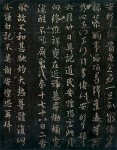Posts Tagged ‘Wang Xizhi’
Father and son: Wang Xizhi and Wang Xianzhi
Chinese characters and calligraphy have more important functions. Now let  us know several key creation trends in the development of Chinese calligraphy in the Jin, Tang, Song and Qing dynasties. Leading these creation trends were calligraphic masters of their periods.
us know several key creation trends in the development of Chinese calligraphy in the Jin, Tang, Song and Qing dynasties. Leading these creation trends were calligraphic masters of their periods.
This chapter deals with a father and a son of the Jin Dynasty – Wang Xizhi and Wang Xianzhi. The former was praised as a sage in calligraphy circles. Wang Xizhi was born into a noble family. His grandfather, father and two brothers were senior officials of the imperial court. His family was a calligraphic family too. Historical records show that of the nearly 100 famous calligraphers of the Jin Dynasty, 20 were of the Wang clan. In his youth, Wang Xizhi was once a petty official, who gave up official life to live as a hermit and devote himself to calligraphy. He is said to have created nearly 1,000 calligraphic works, but none of the originals have survived. Those we can see today are copies made by calligraphers of later periods. Of these dozen or so copies, most are in the running and regular scripts, and only one is in the cursive script.
wp-att-882″ href=”http://www.chinascan.org/archives/874/two-notes-of-running-script-by-xie-an”> Wang Xizhi learnt calligraphy from his father first, and then from the famous woman calligrapher Madam Wei. In middle age, he crossed the Yangtze River to visit many famous mountains in north China, met many famous calligraphers and examined a lot of stele inscriptions. He studied calligraphic theory and developed a natural and unrestrained new style. For a time, this new style was adopted by the sons and nephews of the famous contemporary calligrapher Yu Yi, much to the latter’s chagrin. But before long ,Yu Yi himself admired Wang’s new style for its vividness and shiningness.
Wang Xizhi learnt calligraphy from his father first, and then from the famous woman calligrapher Madam Wei. In middle age, he crossed the Yangtze River to visit many famous mountains in north China, met many famous calligraphers and examined a lot of stele inscriptions. He studied calligraphic theory and developed a natural and unrestrained new style. For a time, this new style was adopted by the sons and nephews of the famous contemporary calligrapher Yu Yi, much to the latter’s chagrin. But before long ,Yu Yi himself admired Wang’s new style for its vividness and shiningness.
Wang’s new style was a milestone in the history of Chinese calligraphy,  praised as a pleasing departure from the old styles of Zhong You and Zhang Zhi of the Eastern Han Dynasty.
praised as a pleasing departure from the old styles of Zhong You and Zhang Zhi of the Eastern Han Dynasty.
Xie An, a grand councilor of the Jin Dynasty, was one of the 41 man of letters who gathered at the Orchid Pavilion (see p. 5). He learnt the cursive script from Wang. Wang Xianzhi was once an official of the imperial court, of higher rank than his father. Like his father, he was a man of integrity. When Xie An asked him to write Part of an inscription for a new hall, he refused, because he thought the elegant hall had been built against the will of the people. A legend has it that in his teens, he told his father that the “zhang cao” cursive script was too restricted, and proposed developing a new style midway between the cursive and running scripts. Later, Wang Xianzhi developed the unique running-cursive script. His Short Note of Duck-Head Pill in the running script (see next page) contains 15 characters in two lines. All the characters are natural and smooth, unrestrained and lyrical. In this, he surpassed his father.
According to Sun Guoting’s Treatise on Calligraphy, one day, Xie An asked Wang Xianzhi, “In comparison with your father’s handwriting, what do you think of your own?” Wang answered, “Certainly, my handwriting is better than my father’s.” “But the critics do not think so,” said Xie An. “They do not understand,” said Wang Xianzhi. Sun Guoting criticized Wang for this. But this short note shows that his handwriting is in fact better than his father’s. In his On Calligraphy, Zhang Huaiguan of the Tang Dynasty said that Wang Xianzhi possessed exceptional talent, and developed a new style different from both the running and cursive scripts. This new style was unrestrained, and became very fashionable.
 The Jin Dynasty was racked by internal disturbances and foreign invasions, and many talented people forsook politics for intellectual and philosophical pursuits. Scholars sought to explore life and demanded the liberation of the personality in a revival of the “hundred schools of thought.”
The Jin Dynasty was racked by internal disturbances and foreign invasions, and many talented people forsook politics for intellectual and philosophical pursuits. Scholars sought to explore life and demanded the liberation of the personality in a revival of the “hundred schools of thought.”
Following this trend, literature and art got rid of the shackles of Confucian doctrine step by step, and sought ways to express emotions and feelings with charm and vigor. Calligraphy, the most concentrated expression of the aesthetic viewpoint of the Jin Dynasty, emphasized the expression of inner emotions and feelings through the patterns of dots and strokes. Calligraphers vied each other to update their handwriting techniques, patterns of characters and structures, thus pushing calligraphic art to its first historical peak.